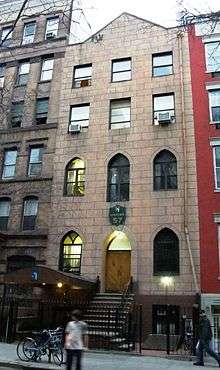Club 57
 In 2009 | |
| Address | 57 St. Mark's Place |
|---|---|
| Location | Manhattan, New York City |
| Coordinates | 40°43′42″N 73°59′11″W / 40.728316°N 73.986354°WCoordinates: 40°43′42″N 73°59′11″W / 40.728316°N 73.986354°W |
| Type | Nightclub |
| Closed | around 1983 |
Club 57 was a nightclub located at 57 St. Mark's Place in the East Village, New York City during the late 1970s and early 1980s. It was founded by Stanley Zbigniew Strychacki. It was a hangout and venue for performance- and visual-artists and musicians, including Madonna, Keith Haring, Cyndi Lauper, Charles Busch, Klaus Nomi, The B-52s, RuPaul, Futura 2000, Kenny Scharf, Frank Holliday, Staceyjoy Elkin, John Sex, Wendy Wild, The Fleshtones, Joey Arias, Lypsinka, Michael Musto, Marc Shaiman, Scott Wittman, Fab Five Freddy, Jacek Tylicki, and to a lesser extent, Jean-Michel Basquiat.
Creation
It was started in the basement of the Holy Cross Polish National Church on St. Mark's. Ann Magnuson, who managed the club and hosted events, described it as home to "pointy-toed hipsters, girls in rockabilly petticoats, spandex pants, and thrift-store stiletto heels...suburban refugees who had run away from home to find a new family...who liked the things we liked - Devo, Duchamp, and William S. Burroughs - and (more important) hated the things we hated - disco, Diane von Fürstenberg, and The Waltons."[1]
Magnuson describes a "Punk Do-It-Yourself aesthetic" which inspired events such as:
- A theatrical remake of "The Bad Seed" by andy rees
- Erotic Day-Glo art shows
- Theme parties (or "enviroteques")
- Putt-Putt Reggae Night (miniature golf played on a course made of refrigerator boxes designed to resemble a Jamaican shantytown)
- Model World of Glue Night (New York's hippest built airplane and monster models, burned them, and sniffed the epoxy)[1]
People involved
Dany Johnson was the resident DJ of the club. Guest DJs included Johnny Dynell and Afrika Bambaataa.
Tom Scully and Susan Hannaford ran a Monster Movie club on Tuesday nights. Drew Staub remembers at 9:00 Tuesdays “they’d show the really worst monster movie that they could find. And everybody would scream and drink and carry on. I was the house critic of the movie… I was known for that, and it used to gain me free admission.”[2] Hannaford has relocated to Berlin and opened the Berlin Tea Room in August 2006.
Keith Haring used to perform from inside a fake television set, and read his "neo-dada poems"[3] at the Club 57 Wednesday night poetry readings,[4] and later put on evenings and exhibitions there. He curated the Black Light Show there, an early show of his own works (1981), and an exhibition of Kenny Scharf's hand customized appliances.
Besides Magnuson's input, the main contribution to the Club 57 style was from (mostly gay) School of Visual Arts undergraduate students (including Haring, Holliday, Scharf and Sex), who used it as a playground. “At Club 57 there were drugs and promiscuity—it was one big orgy family. Sometimes I’d look around and say, “Oh, my God! I’ve had sex with everybody in this room!” It was just the spirit of the times—and it was before AIDS" remembers Scharf, "Everybody there was either living together or sleeping together." Drew Staub agreed.[2] Scharf recalls that "Ann Magnuson may have been twenty-four, but she was like our mom."[2] Jean-Michel Basquiat fell out with Kenny Scharf, in part over Club 57: "esthetically I really hated Club 57. I thought it was silly. All this old and bad shit. I’d rather see something old and good.”[5]
Other contributors included Shawn McQuate the Great aka AMMO, dancer, performance-artist and designer. Stacey Elkin and Shawn were known as the fashion designers of the club, and made costumes for many of the Club 57 performers, like Magnuson, Scharf, and model and artist Kitty Brophy. McQuate the Great/Shawn AMMO was John Sex's boyfriend for two years during the early club days. McQuate did several happenings, including having 50 performance artists performing at the same time, in Uniersal Interaction 1981. Also, Ande Whyland, Photog., Bob Carruthers, photog., Minn Thometz-Sanchez, dancer/personality, and so many others played a vital role in the clubs aesthetic. [6]
Later years and closure
Ann Magnuson left her position as manager of Club 57 soon after forming the band Pulsallama, and just before being cast in The Hunger with David Bowie." [5] Andy Rees took over bring Marc Shaiman andScott Whitman.
In 1981 Steve Mass of Mudd Club began showing up at Club 57, and began hiring Club 57 crowd to help acquire part of that scene. Keith was later hired to curate shows at the Mudd Club.[5]
Club 57 closed in the early 1980s – "around 1983", according to Magnuson[1] – after the community of artists moved on to larger and more expensive venues, and many concurrently began to suffer from AIDS.
References
Notes
- 1 2 3 Ann Magunson, "The East Village 1979-1989 A CHRONOLOGY: ANN MAGNUSON ON Club 57", Artforum, Oct, 1999. full text.
- 1 2 3 Gruen, John (ed.) Keith Haring: The Authorized Biography New York: Prentice Hall, 1991.
- ↑ Musto, Michael. Downtown. Vintage Books, 1986.
- ↑ Karing, Keith. (September 21, 1979 entry), Keith Haring Journals, Viking, 1996.
- 1 2 3 Hager, Steve. Art After Midnight: The East Village Scene. St. Martin. 1986.
- ↑ Facebook "In With the In Crowd- Club 57" page managed by Drew Straub
Further reading
- Reynolds, Simon: Rip It Up and Start Again: Postpunk 1978-1984, Penguin Books, February 2006, pgs. 264-266, 278-279.
- Van Pee, Yasmine. Boredom is always counterrevolutionary : art in downtown New York nightclubs, 1978-1985 (M.A. thesis, Center for Curatorial Studies at Bard College, 2004).